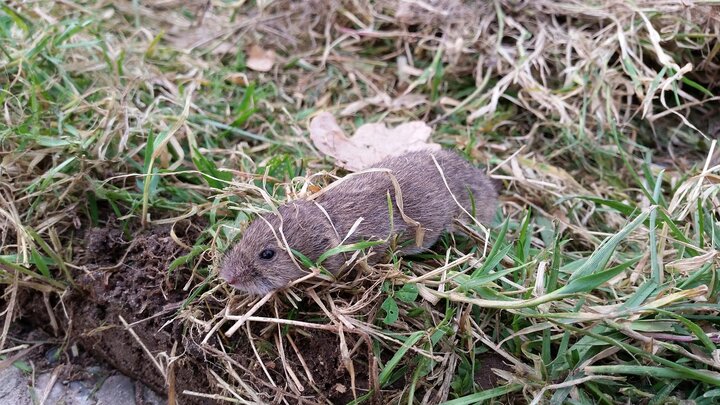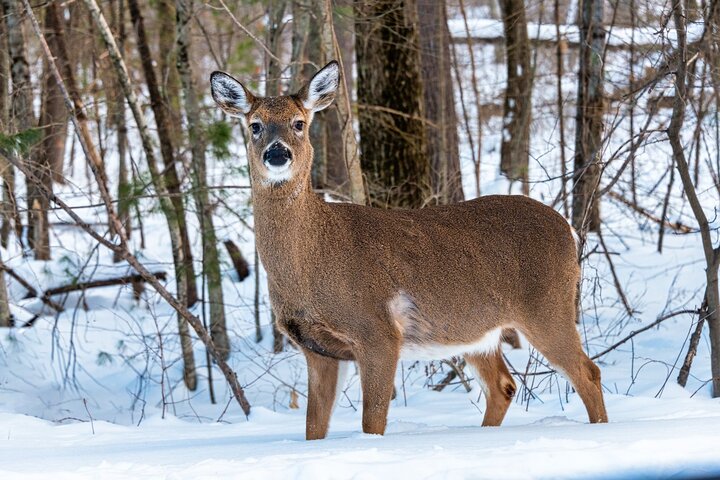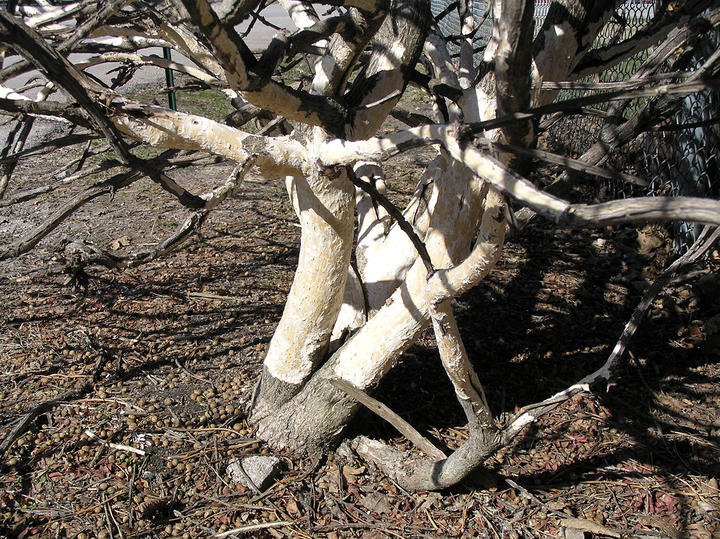Sarah Browning, Nebraska Extension Educator

Cottontail rabbits can cause plant damage at any time of year, but particularly when food sources are scarce in winter. Image from Pixabay.com.
Failure to protect fruit trees and landscape ornamentals against gnawing rodents, rabbits and deer this fall can result in a nasty surprise next spring: girdled trunks or stems, and broken branches. Late fall is the time to get protection in place and safeguard the health of your plants. Prevention is the only way to protect trees and shrubs from injury since very little can be done to salvage plants once the damage is done.

Voles and Rabbits
Voles and rabbits often feed on the bark of fruit trees and ornamental plants. Most homeowners are familiar with cottontail rabbits but are often not as well-acquainted with voles, a short-tailed relative of the common mouse. Voles have compact, stocky bodies with small eyes and ears, partially hidden by their gray or brown fur, and a shorter tail than a common mouse.
Voles generally do their dirty work beneath the concealment of tall grass, snow or mulch piled up against the tree’s trunk.
Thus, the first step in protecting trees against rodents is to mow and trim around trees, remove weeds and other shrubby vegetation, and eliminate woodpiles, stacks of lumber, brush piles and other materials which provide hiding places for mice and rabbits.
Next, pull mulches back from the trunk of new plants to eliminate this source of winter protection for foraging voles. Throughout fall and winter, inspect plants regularly to discover and solve any rodent problems as soon as possible.
Protection Methods
Because it takes only one gnawing animal to do a great deal of damage, eliminating hiding sites is only the start. More aggressive measures are needed to really protect woody plants, including physical barriers and taste or smell repellents.
Physical Barriers
Constructing a physical barrier around plants is the most effective method of control. Make a cylinder of hardware cloth, using ¼-inch mesh to prevent both rabbit and vole damage. Encircle each plant and bury the wire 6 inches in the soil to prevent voles from tunneling underneath.
Rabbits sit on top of the snow and gnaw on the trunk and branches. Therefore, protection must extend from the soil to 18 to 24 inches above the usual snow depth.

PVC pipe or white plastic drain tile (as found in plastic downspout extenders) can also be used to protect young trees from rabbits and vole, but also provides protection against deer antler-rubbing damage. Deer damage occurs during their breeding season from October through January. Cut a section long enough to cover the tree's trunk up to the lowest branch. Slit the pipe down one side and fit it around the tree's trunk.
For more information on physical barriers and fencing to protect larger areas, including how to construct a peanut butter fence, visit Managing Deer Damage in Nebraska.
Taste and smell repellents
Effective control with repellents is variable – sometimes they work and sometimes they don’t. But if you don’t want to put up a fence to keep the deer out, they’re worth a try. Just keep in mind, the repellent won’t eliminate all damage, especially during difficult winter conditions, but it may help keep damage to a minimum.

Taste repellents are most effective when applied directly to the plants being protected. Deer need to get the repellent in their mouth to be discouraged from feeding. Taste repellents should not be applied to edible plants during the growing season after fruit set. Taste repellents include putrescent whole egg solids and capsaicin, along with others.
Putrescent egg solids, basically decomposing eggs, emit a sulfur-like odor thought to mimic the smell of predator urine and discourage deer activity. It functions as both a taste and scent repellent.
Scent repellents, like dried blood and garlic, don’t have to be ingested to be effective so can be applied on or around the plants to be protected.
Several repellents are commonly available in garden or big box stores.
- Natures MACE – Deer & Rabbit Mace contains dried blood, putrescent whole egg solids, garlic and peppermint oil which serve as both smell and taste repellents. It’s labeled for use in gardens, lawns and landscapes. Reapplication is recommended every 3-4 weeks.
- Bonide Go Away – Deer & Rabbit Repellent contains capsaicin. It’s labeled for use on fruits, vegetables, citrus, ornamentals and grasses. Reapplication is recommended every 3-7 days for 2-3 weeks, until control is established.
- Safer Critter Ridder – Deer & Rabbit Repellent contains putrescent whole egg solids, capsaicin and garlic, acting as a taste and smell repellent. It’s labeled for use in gardens, lawns and landscapes. Reapplication is recommended every 90 days.
Repellents can be fairly effective if animals have other food sources available nearby. But if animal populations are so high, the weather so severe or food so scarce that animals are nearing starvation, they will eat even the nastiest tasting stuff to survive.
Additional Resources
Images
- Voles have compact, stocky bodies with small eyes and ears, partially hidden by their gray or brown fur, and a shorter tail than a common mouse. Image from Pixabay.com.
- Whitetail deer can damage landscape plants through feeding or antler rubbing. Image from Pixabay.com.
- Winter rabbit damage to burning bush, Euonymus alatus. Image by Sarah Browning, Nebraska Extension.
Search Our Archive
Associated Video
Vole, Mole or Mouse
Nebraska Extension Wildlife Specialist Dennis Ferraro shows the difference between a vole, a mole and a mouse and talks about strategies to control them in the landscape or around your home.